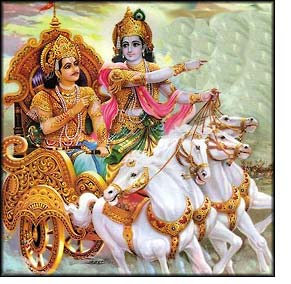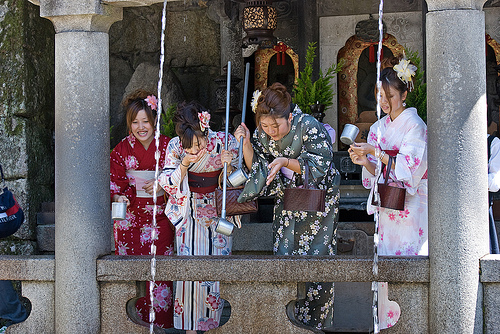Please read the First Part and then read it for better understanding.
வினையே ஆடவர்க்கு உயிரே
கீதையில் கண்ணன் கூறுகிறான் (3-5, 3-8):எவனும் ஒரு வினாடி கூட கருமம் செய்யாமல் இருக்க முடியாது. நீ விதிக்கப்பட்ட கடமையைச் செய். கருமம் செய்யாமையினும் கருமம் செய்தல் சிறந்தது அன்றோ. கருமம் செய்வதற்கே உனக்கு அதிகாரம். அதன் பற்றில் அல்ல(2-47)
பாலை பாடிய பெருங் கடுங்கோ (குறு.135) கூறுகிறார்: தொழில் தான் ஆண் மக்களுக்கு உயிர். இல்லத்தில் வாழும் பெண்களுக்கு கணவனே உயிர்.
வினையே ஆடவர்க்கு உயிரே வாணுதல்
மனையுறை மகளிர்க்கு ஆடவர் உயிரே
அகம் 33: வினை நன்றாதல் வெறுப்பக் காட்டி
மேலும் சில: குறள் 615
செல்வத்தின் பயனே ஈதல்
கீதையில் கண்ணன் கூறுகிறான் (3-13): எவர்கள் தமக்கெனவே சமைக்கிறார்களோ அவர்கள் பாவிகள். அவர்கள் பாவத்தையே உண்கிறார்கள்.
(புறம் 189 நக்கீரனார்):
உண்பது நாழி:உடுப்பவை இரண்டே;
பிறவும் எல்லாம் ஓரொக்கும்மே;
அதனால் செல்வத்துப் பயனே ஈதல்
புறம் 182( இளம்பெருவழுதி)
இந்திரர் அமிழ்தம் இயைவது ஆயினும், இனிது
எனத் தமியர் உண்டலும் இலரே
இதுவுமது: குறு. 143, குறள்-322, 85, 335, 333
கொடுப்போர் ஏத்தி கொடார்ப் பழிப்போர் (தொல்காப்பியம்)
சர்வ பூத ஹிதே ரதா: (எல்லா உயிர்க்கும் இன்பம்)
கீதையில் கண்ணன் கூறுகிறான்(12-4): எல்லா உயிர்க்கும் இன்புற்றிருக்க நினைக்கும் அன்பர்கள் என்னையே வந்தடைவார்கள்.
இதுவுமது: கீதை 11-55,9-29,5-25,6-40
சாஸ்வத்ஸ்ய சுகஸ்ய (கீதை 14-27): யாண்டும் இடும்பை இல (குறள்)
தொல்காப்பியரும் “எல்லா உயிர்க்கும் இன்பம்” என்று கூறுகிறார்.
ஐங்குறுநூற்றில் ஓரம் போகியார் :(இவர் வேத, உபநிஷத மந்திரங்களை அப்படியே மொழி பெயர்த்துள்ளார். இந்தக் கருத்து கீதையில் பல இடங்களில் வருகிறது)
நெற்பல பொலிக பொன்பெரிது சிறக்க
விளைக வயலே வருக இரவலர்
பால் பல ஊறுக பகடு பல சிறக்க
பகைவர் புல் ஆர்க பார்ப்பார் ஓதுக
பசியில்லாகுக பிணிகேண் நீங்குக
வேந்து பகை தணிக யாண்டு பல நந்துக
அறநனி சிறக்க அல்லது கெடுக
அரசு முறை செய்க களவில்லாகுக
நன்று பெரிது சிறக்க தீதில்லாகுக
மாரி வாய்க்க வள நனி சிறக்க
(பிராமணர்கள் எங்கே பூஜை செய்தாலும் முடிவில்– ஸ்வஸ்தி ப்ரஜாப்ய பரிபாலயந்தாம்– என்ற மந்திரத்தையும், –காலே வர்ஷது பர்ஜன்ய: –என்ற மந்திரத்தையும்– ஸர்வேஷாம் சாந்திர் பவது/ மங்களம் பவது –என்ற மந்திரத்தையும் சொல்லி வாழ்த்துவார்கள். இதை –வாழ்க அந்தணர் வானவர் ஆனினம்– என்ற பாடலாக ஞான சம்பந்தரும் மொழி பெயர்த்துள்ளார். சைவர்கள் இதையே –வான்முகில் வளாது பெய்க—என்ற பாடலில் கூறுவார்கள். ஆனால் ஒரம் போகியார் பல மந்திரங்களைத் தொகுத்து அழகாக சுருங்கச் சொல்லி விளங்கவைத்து விட்டார்.
உள்ளுவதெல்லாம் உயர்வுள்ளல் (குறள் 596)
கீதையில் கண்ணன் கூறுகிறான் (கீதை 6-5):உன்னை நீயே உயர்த்திக் கொள்ளவேண்டும்; உன்னை நீயே தாழ்த்திக் கொள்ளக் கூடாது, உனக்கு நீயே நண்பன், நீயே பகைவன்.
(கீதை 11-33) எழுந்திரு ! புகழடை!! உத்திஷ்ட ! யசோ லப !!
புறம் 214 (கோப்பெருஞ் சோழன்): யானை வேட்டைக்குப் போகிறவன் வெல்வான். குறும்பூழ் வேட்டைக்குப் போவோன் அது இல்லாமலும் திரும்புவான். உயர்ந்த குறிக்கோளுடன் கூடிய உயர்ந்தோனாக விளங்குக. இமயம் போல் புகழ் அடைக.
யானை வேட்டுவன் யானையும் பெறுமே
குறும்பூழ் வேட்டுவன் வறுங்கையும் வருமே
அதனால், உயர்ந்த வேட்டத்து உயர்ந்திசினோர்க்கு
………….
இமயத்துக் கோடுயந்தென்ன தம்மிசை நட்டு
புறம் 190 (நல்லுருத்திரன்): எலி, திருடிச் சேமித்துத் தின்னும். புலி இடப் பக்கம் விழுந்த பன்றியை விட்டு வலப்பக்கத்து விழுந்த யானையையே சாப்பிடும். அப்படிப்பட்ட உயர்ந்த நோக்கம் கொண்டோருடன் சேர்வாயாக.
கடல் நிரம்பாத அதிசயம் (கீதை 2-70)
கீதையில் கண்ணன் கூறுகிறான்: எங்கும் நிரம்பியதும் நிலை குலையாததுமான கடலில் நதிகள் போய் சங்கமிப்பது போல ஆசைகள் எல்லாம் எவனை அடைகின்றனவோ அவன் அமைதியை அடைவான். ஆசையைத் தொடர்பவனுக்கு அமைதி இல்லை.
பரணர் கூறுகிறார்: கடல்களில் எவ்வளவோ நதிகள் கலந்தாலும் அது நிரம்பி வழிவதில்லை. கடலிலிருந்து எவ்வளவு மேகங்கள் நீரை உறிஞ்சினாலும் அது வற்றுவதில்லை.
மழைகொளக் குறையாது புனல் புக நிறையாது
விலங்கு வளி கடவும் துளங்கிருங் கமஞ்சூள் –(பதிற்றுப் பத்து 45)
உவமை
பிறர்க்கு உவமம் தான் அல்லது
தனக்கு உவமம் பிறர் இல் (உலோச்சனார், 377)
உரவோர் எண்ணினும் மடவோர் எண்ணினும்
பிறர்க்கு நீ வாயின் அல்லது
நினக்குப் பிறர் உவமம் ஆகா (ப. பத்து, அரிசில் கிழார்)
கீதையில் கண்ணன் கூறுகிறான் (கீதை 6-32:) எவன் எங்கும் சுகமாயினும் துக்கமாயினும் தன்னை உபமானமாகக் கொண்டு சமமாகப் பார்க்கிறானோ அந்த யோகிதான் சிறந்தவன் என்பது என் முடிவு
உவமை, உவமேயம் ஆகியன சம்ஸ்கிருத சொற்கள். ஆயினும் சங்கப் புலவர்களோ தொல்காப்பியரோ அவைகளை அப்படியே பயன் படுத்த அஞ்சியதில்லை!
இதுவுமது: புறம் 377,மது 516,பதி73-7, தொல்காப்பியம்-உவமவியல்
சம தர்சனம்-ஓடும் பொன்னும் ஒக்க நோக்குவர்
கீதையில் கண்ணன் கூறுகிறான் (5-18) : பசு, பார்ப்பனன், யானை, நாய், நாயை உண்ணும் புலையன் ஆகிய எல்லாவற்றிலும் ஆத்ம ஞானிகள் சம தர்சனம் உடையவர்கள். இன்ப துன்பத்தில் சமமாக இருப்பவனும் ஓடு,கல்,தங்கம் ஆகியவற்றைச் சமமாகப் பார்ப்பவனும் உயர்ந்தவன்.(14-24). புலன்களை வென்று மண், கல், தங்கத்தை சமமாகப் பார்ப்பவன் யோகி.(6-8)
கனியன் பூங்குன்றன் (புறம் 192) பக்குடுக்கை நன்கணியார் (194)
யாதும் ஊரே; யாவரும் கேளிர்;
தீதும் நன்றும் பிறர் தர வாரா;
நோதலும் தணிதலும் அவற்றோரன்ன;
சாதலும் புதுவது அன்றே; வாழ்தல்
இனிது என மகிழ்ந்தன்றும் இலமே; முனிவின்,
இன்னாது என்றலும் இலமே:
பொருள்: எல்லா ஊர்களும் எம் ஊரே, எல்லாரும் எம் உறவினரே. தீமையும் நன்மையும் யாரும் தருவதில்லை. நம்மால்தான் வருகிறது. இறப்பது புதிய செய்தி அல்ல.வாழ்வதால் மகிழ்ச்சியோ அல்லது அதை வெறுப்பதோ இல்லை பெரியாற்று வெள்ளத்தில் மிதவை அடித்துச் செலவது போல எல்லா உயிர்களும் முறையாகக் கரை சேரும் என்பது துறவியர் கண்ட உண்மை.ஆகையால் பெரியோரை மதிக்கவும் சிறியோரை இகழவும் தேவை இல்லை. அவரவர் ஒழுக்கத்தையே கருத்திற் கொள்வோம் ( ஒன்றாகக் காண்பதே காட்சி என்பதை அழகாகச் சொல்லிவிட்டார்)
நன்கணியார் (194) கூறுகிறார்: என்ன உலகம் இது? ஒரு வீட்டில் சாவுக் கொட்டு. மற்றொரு வீட்டில் திருமண மேளம். ஒரு வீட்டில் மகளிர் அழுகை. இன்னொரு வீட்டில் மகளிர் பூச்சூடல். இவ்வாறு இன்பமும் துன்பமும் சேர படைத்துவிட்டானே கருணையே இல்லாத பிரம்மா! இதை உணர்ந்து அல்லாதவற்றை ஒதுக்கி இனியவற்றை மட்டும் கண்டு மகிழுங்கள் (“ இன்னாது அம்ம இவ் உலகம்; இனிய காண்க, இதன் இயல்புணர்ந்தோரே”)
(190 முதல் 198 வரை எல்லாம் தத்துவப் பாடல்கள்)
போரின் கொடுமைகள்
போரின் கொடுமைகள் பற்றி புறம் 62ல் கழாத்தலையார் பாடுகிறார். இதையே கீதையின் முதல் அத்தியாயத்தில் அர்ஜுனனும் கூறுகிறான்.
ஆணின் ஆறு பண்புகள்
நற்றிணை 160: நீதி, நட்பு, இழிசெயலைக் கண்டு நாணுதல்,பிறர்க்கு பயன்படல், (பரோபகாரம்), நற்குணங்கள், பிறை தன்னை அறிந்து ஒழுகும் பாங்கு ஆகிய 6 பண்புகளை நான் கடைப் பிடிக்கிறேன்.
அகம் 173 பாடலில் முள்ளியூர் பூதியாரும் அறநெறியில் ஒழுகவேண்டும், பிறர் துன்பத்தைத் துடைக்க வேண்டும் என்று கூறுகிறார். கீதையின் 12ம் அத்தியாயத்தில் கண்ணன் பல நற்பண்புகளை விவரிக்கிறார். கீதை முழுதுமே நூற்றுக் கணக்கான இடங்களில் இத்தகைய கருத்துக்கள் வருகின்றன.
இம்மை, மறுமை—அற நிலை வணிகன்
கீதையில் கண்ணன் கூறுகிறான் (2-42/43): வேதத்தின் பெயரால் சொற்சிலம்பம் ஆடுவோர் அழகான வார்த்தைகளால் சுவர்க்கத்தை மனதிற் கொண்டு காரியம் செய்வார்கள்.
மேலும் சில: கீதை 2-49; 17-20,21,22
ஆய் பற்றி முடமோசியார் (புறம் 134)
இம்மைச் செய்தது மறுமைக்கு ஆம் எனும்
அறநிலை வணிகன் ஆய் அல்லன்
கீதையிலும் தமிழ் இலக்கியத்திலும் நூற்றுக் கணக்கான இடங்களில் வருவதால் இனியும் கூறத்தேவை இல்லை

சிலப்பதிகாரத்தில் இளங்கோ கூறிய கீதைக் கருத்துக்கள்:
”தெய்வம் தெளிமின் தெளிந்தோர்ப் பேணுமின்
பொய்யுரை அஞ்சுமின் புறஞ்சொல் போற்றுமின்
ஊனூண் துறமின் உயிர்க்கொலை நீங்குமின்
தானம் செய்ம்மின் தவம்பல தாங்குமின்.
செய்ந்நன்றி கொல்லன்மின் தீநட் பிகழ்மின்
பொய்க்கரி போகன்மின் பொருண்மொழி நீங்கன்மின்
அறவோர் அவைக்களம் அகலாது அணுகுமின்
பிறவோர் அவைக்களம் பிழைத்துப் பெயர்மின்
பிறர்மனை அஞ்சுமின் பிழையுயிர் ஓம்புமின்
அறமனை காமின் அல்லவை கடிமின்
கள்ளும் களவும் காமமும் பொய்யும்
வெள்ளைக் கோட்டியும் விரகினில் ஒழிமின்
இளமையும் செல்வமும் யாக்கையும் நிலையா
உளநாள் வரையாது ஒல்லுவ தொழியாது.
இன்னும் பல தலைப்புகளில் ஒற்றுமை உள்ளது. அவைகளை எல்லாம் GREAT MEN THINK ALIKE என்று விட்டுவிடலாம். ஆனால் ஒன்று மட்டும் உண்மை. இந்திய சிந்தனையில் ஆரிய திராவிட என்ற பிரிவினவாதத்துக்கு இடமே இல்லை. இமயம் முதல் குமரி வரை அற்புதமான ஒரே சிந்தனை!! அதிசயமான ஒரே அணுகுமுறை. படிக்கப் படிக்கத் தெவிட்டாது!!
Also available One Minute Bhagavad Gita, Krishna’s Restaurant vegetarian food
**************************


























































You must be logged in to post a comment.